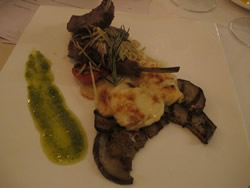|
 A winery in Piemonte (Piedmont) in the North western part of Italy owned by Americans and registered in Lichtenstein with a website predominantly in German and selling online from Lichtenstein can be as complex as a Barolo. But it’s even more complex when you have a Swiss national Carmen Heinrich coming to India to taste three wines and take a feedback. But wait, it’s not over yet-She is originally from Bavaria where she admits growing up on beer and not milk! (Some of our full- fat milk drinking politicians, decision makers and even teetotallers might want to make a mental not of it). A winery in Piemonte (Piedmont) in the North western part of Italy owned by Americans and registered in Lichtenstein with a website predominantly in German and selling online from Lichtenstein can be as complex as a Barolo. But it’s even more complex when you have a Swiss national Carmen Heinrich coming to India to taste three wines and take a feedback. But wait, it’s not over yet-She is originally from Bavaria where she admits growing up on beer and not milk! (Some of our full- fat milk drinking politicians, decision makers and even teetotallers might want to make a mental not of it).
A felicitator for EU business with India, Carmen is perhaps the right person for the job assigned to her as the Senior Consultant by the boutique winery- she has lived in India for a few years and comes back regularly and hence knows the problems and issues specific to India, including the latest roadblock created by FSSAI.
The Rosoretto Winery is situated in the heart of the Barolo region, 12 kilometres drive from the Piedmontese wine capital city of Alba, in the comune (community) of Castiglione Falletto. Barolo is produced in the heart of Langhe hills in 11 different municipalities/towns, the more important being Barolo, La Morra, Castiglione Falletto, Serralunga d’Alba and Monforte d’Alba. (Other comunes included are Verduno, Novello, Grinzane Cavour, Roddi, Cherasco and Diano d’Alba). For details please visit one of the earlier articles, Barolo and Barbaresco- Burgundy of Piemonte
Rosoretto Roero Arneis docg 2012 was the first wine to be tasted. Arneis has been a rising star of white grapes in this region, sometimes known as ‘white Barolo’. It has been known to exist for at least 500 years but became increasingly less popular for various reasons till it faced almost extinction during the last century. Its revival in the 1980s coincided with the technological innovations at that time saw the wines improve in quality to the extent that first getting the doc status. Arneis from Roero was elevated to the docg status in 2005.
The Rosoretto Roero Arneis 2012 was dark golden coloured wine with orange hue with a lot of minerality and shades of oak but bordering on oxidation, I felt. I found it neither fresh nor crisp but with a lot of minerality. Even the fruit was lacking for me. Mercifully, everyone else was raving about it on the table, finding it fresh and crisp and delightful. For me, it failed my litmus test-I can normally drink a full bottle of decent Roero Arneis with aperitifs during an evening but had to labour hard to finish my glass. It was perhaps so due to travel or poor storage. It’s no help that the varietal is prone to oxidation. 82/100
 My numbed olfactory senses were awakened and even heightened as I tasted the Rosoretto Barbera d’ Alba 2011 served with the tortellini with meat grounds and ragù Bolognaise. Barbera d’Alba is a wine that has gained in stature during the last 15-20 years with part maturing it in oak casks bringing elegance to what were otherwise mere quaffable wines for a long time. I could have ‘drank’ all night and still have begged for more! It was a heavenly match with the Emilia Romagna style pasta. The wine was fruity and with underlined acidity that would handle any pasta perfectly. Especially with a dash of olive oil that Carmen had brought from the winery. A shade of oak-it was aged for 6 month in oak barrels, had made it complex and elegant with a lovely balance. The soft and ripe tannins went well with the meat as well as the tortelli- the second course of pasta which was even more delicious than the delectable tortellini earlier. Very satisfying and satisfactory wine indeed! 91/100 My numbed olfactory senses were awakened and even heightened as I tasted the Rosoretto Barbera d’ Alba 2011 served with the tortellini with meat grounds and ragù Bolognaise. Barbera d’Alba is a wine that has gained in stature during the last 15-20 years with part maturing it in oak casks bringing elegance to what were otherwise mere quaffable wines for a long time. I could have ‘drank’ all night and still have begged for more! It was a heavenly match with the Emilia Romagna style pasta. The wine was fruity and with underlined acidity that would handle any pasta perfectly. Especially with a dash of olive oil that Carmen had brought from the winery. A shade of oak-it was aged for 6 month in oak barrels, had made it complex and elegant with a lovely balance. The soft and ripe tannins went well with the meat as well as the tortelli- the second course of pasta which was even more delicious than the delectable tortellini earlier. Very satisfying and satisfactory wine indeed! 91/100
Rosoretto Barolo Parussi 2009 was a very good choice for finishing the meal. Although quite young (I don’t recommend a good Barolo to be opened for 8- 10 years from the vintage) this classic unfiltered Barolo did have rough edges and harsh tannins despite a couple of hours of decanting. I had been practical enough to change my main course dish from the Grilled Pork with French Fries (why the fries, for Pellegrino Artusi’s sake! Steak fries or some other innovation might go better for fine dining, I thought) to the NZ lamb. It was a made-for-each-other classic pairing that did not disappoint. I would have loved to have a couple of bottles stored away for 3-5 years and compared with the same food then. Artusi is an excellent addition to Delhi’s Italian cuisine necklace and would age as well as the Barolo and would get even better during this period for the scientific experiment that Pellegrino Artusi would have appreciated. 90/100
 A special word for Artusi Restaurant and the owner Oscar Balcon, the ex-banker Italian smitten by restaurant business and his Indian wife! And wine. The cuisine from Emilia Romagna is a breath of fresh air. The pasta was really a winner and would have perhaps touched an unprecedented high on the palate if he could manage shavings of white truffles which Piemonte is well known for. But a big feature of the 5-month old restaurant is Oscar. I saw him greet guests personally and even accompany some to the table. When I made the mistake of asking him where the toilet was, he accompanied me to the spot from where one goes down the stairs into a rather pretty toilet area. He acts with humility and looks after the modern kitchen and the guests proficiently. A special word for Artusi Restaurant and the owner Oscar Balcon, the ex-banker Italian smitten by restaurant business and his Indian wife! And wine. The cuisine from Emilia Romagna is a breath of fresh air. The pasta was really a winner and would have perhaps touched an unprecedented high on the palate if he could manage shavings of white truffles which Piemonte is well known for. But a big feature of the 5-month old restaurant is Oscar. I saw him greet guests personally and even accompany some to the table. When I made the mistake of asking him where the toilet was, he accompanied me to the spot from where one goes down the stairs into a rather pretty toilet area. He acts with humility and looks after the modern kitchen and the guests proficiently.
Carmen Heinrich must have collected nugget of information talking about the wine market in India at the dinner. Undoubtedly, the wines are good but the pricing and servicing the market by a small winery would be the main issues before the winery can appoint an importer and invest in the market as complex as a Barolo.
Everyone now understands that India is a long term market but despite the roadblocks by the likes of FSSAI and other governmental procedures, Piedmontese wines are well suited for Indian palates-in fact Barolo has become a popular ‘brand’ for the affluent-connoisseurs and novices alike-even if the people don’t know it is merely a super appellation in Piedmont that allows only 100% Nebbiolo grapes in the wine that must age 4 years and should be drunk after at least 8-10 years-Rosoretto Barolo Prussi claims it should age for 15 years. This sounds conservative estimate after tasting of the trinity of wines from Rosoretto at Restaurant Artusi- named after Pellegrino Artusi, the 19th century businessman and writer who is known for the first cook book in Italy.
For related articles, please also visit: Roero: Neglected Cousin of Big B
Subhash Arora |